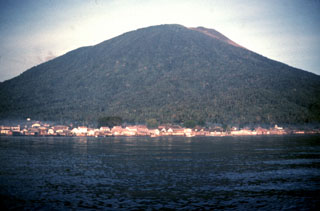Report on Gamalama (Indonesia) — December 2015
Bulletin of the Global Volcanism Network, vol. 40, no. 12 (December 2015)
Managing Editor: Edward Venzke.
Gamalama (Indonesia) Several weak explosions with plumes during December 2014-September 2015
Please cite this report as:
Global Volcanism Program, 2015. Report on Gamalama (Indonesia) (Venzke, E., ed.). Bulletin of the Global Volcanism Network, 40:12. Smithsonian Institution. https://doi.org/10.5479/si.GVP.BGVN201512-268060
Gamalama
Indonesia
0.81°N, 127.3322°E; summit elev. 1714 m
All times are local (unless otherwise noted)
Gamalama has been intermittently active for many decades, with fluctuating seismicity and occasional weak explosions resulting in ash plumes. Pyroclastic flows occurred in 1993, 1996, and 2003, while a deadly lahar occurred in 2011 (BGVN 18:05, 28:07, 36:12). More recently, a series of small explosions caused ashfall during 15-17 September 2012 (BGVN 37:11). The volcano was quiet until December 2014, when an eruption injured some hikers, with one missing. Ash explosions during 16-20 July 2015 caused about 1,500 people to evacuate. Additional explosions took place on 4 August and 8 September, but activity declined through October 2015.
Following the September 2012 activity, PVMBG lowered the Alert Level on 9 October from 3 to 2 (on a scale of 1-4, where 2 denotes Caution), based on visual and instrument monitoring of volcanic activity. The Alert Level remained at 2 through at least the end of October 2015. Visitors and residents were warned not to approach the crater within a radius of 1.5 km.
According to a news article (Associated Press), an explosion on 18 December 2014 generated an ash plume that rose 2 km. Another news account (Agence France-Presse, as reported by the Australian Broadcasting Corporation) quoted Mansur Mahli, a local disaster management agency official, who stated that 11 hikers were injured while running down the slope during the eruption, and three of them were hospitalized for broken bones.
Slow-moving lava at the summit was visible, and ashfall occurred in local villages. The Sultan Babullah airport, 6 km NE, was closed along with schools and businesses. According to the Darwin Volcanic Ash Advisory Centre (VAAC), ash plumes rose to an altitude of 2.1 km on 24-25 December and drifted almost 30 km SW.
There were no further reports of activity until The Pusat Vulkanologi dan Mitigasi Bencana Geologi (PVMBG, Centre of Volcanology and Geological Hazard Mitigation) noted diffuse white plumes during March through 22 April 2015 that rose as high as 50 m above the summit; on 7 April the plumes became dense and rose 100 m. Seismicity fluctuated but remained generally low.
An explosion on 16 July 2015 generated, according to the Badan Nasional Penanggulangan Bencana (BNPB, National Disaster Management Authority), a gray-and-white plume that rose as high as 1.5 km above the crater and drifted N. The Sultan Babullah International airport was closed on 18 July. Several explosions during 18-19 July produced white-and-gray plumes that rose 300-800 m and drifted NW. The Darwin VAAC reported that during 16-20 July ash plumes rose to altitudes of 2.1-5.5 km and drifted 20-130 km NE, NW, W, and SW. A preliminary count of refugees showed there were 1,505 people (450 families) displaced by the eruption. Ash deposits were 1.5-6 mm thick in northwestern villages.
On 4 August 2015, BNPB reported that Gamalama continued to erupt, although with low intensity; ash fell in nearby communities and tremor was continuous. According to the Darwin VAAC, the ash plume drifted over 20 km NW. BNPB reported that, as of 4 August 2015, the total number of evacuees in shelters was 1,791.
PVMBG reported that a sudden, small explosion from a fissure on the NW flank occurred on 8 September with no precursory seismicity, and produced a plume that rose 1 km above the fissure. The plume was also noted by the Darwin VAAC, which concluded that it rose to an altitude of 3 km and drifted more than 25 km NE. Gray plumes rose from 300-600 m above the vent during 9-24 September.
During 1 October-3 November 2015, white plumes rose as high as 300 m above the main crater and fissures on the E and NW flanks. PVMBG reported that during 1 August-4 November, seismicity fluctuated and was dominated by hybrid earthquakes and signals indicating emissions. Increased seismicity was recorded during 3-5 August, 11-19 August, and 8-22 October 2015, though seismicity declined overall.
Geological Summary. Gamalama is a near-conical stratovolcano that comprises the entire island of Ternate off the western coast of Halmahera, and is one of Indonesia's most active volcanoes. The island was a major regional center in the Portuguese and Dutch spice trade for several centuries, which contributed to the extensive documentation of activity. Three cones, progressively younger to the north, form the summit. Several maars and vents define a rift zone, parallel to the Halmahera island arc, that cuts the volcano; the S-flank Ngade maar formed after about 14,500–13,000 cal. BP (Faral et al., 2022). Eruptions, recorded frequently since the 16th century, typically originated from the summit craters, although flank eruptions have occurred in 1763, 1770, 1775, and 1962-63.
Information Contacts: Pusat Vulkanologi dan Mitigasi Bencana Geologi (PVMBG, also known as CVGHM, Center for Volcanology and Geological Hazard Mitigation), Jl. Diponegoro 57, Bandung, West Java, Indonesia, 40 122 (URL: http://www.vsi.esdm.go.id/); Darwin Volcanic Ash Advisory Centre (VAAC), Bureau of Meteorology, Northern Territory Regional Office, PO Box 40050, Casuarina, NT 0811, Australia (URL: http://www.bom.gov.au/info/vaac/); Badan Nacional Penanggulangan Bencana (BNPB) (URL: http://www. bnpb.go.id); Associated Press (URL: http://www.ap.org/); Agence France-Presse (AFP) (URL: http://www.afp.com/en).

